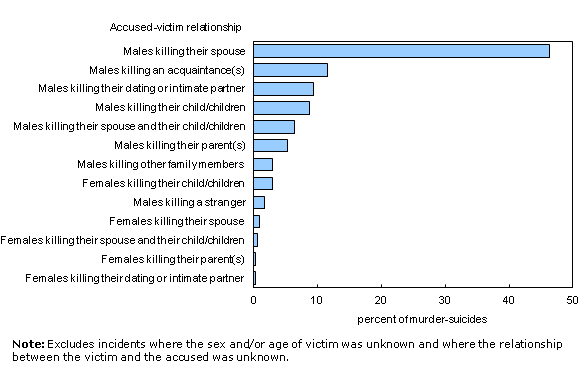Family violence in Canada: A statistical profile, 2011
Archived Content
Information identified as archived is provided for reference, research or recordkeeping purposes. It is not subject to the Government of Canada Web Standards and has not been altered or updated since it was archived. Please "contact us" to request a format other than those available.
Released: 2013-06-25
Family violence accounted for 26% of all police-reported violent crime in 2011, a proportion similar to 2010. About half (49%) of the nearly 95,000 victims of family violence were in a current or previous spousal relationship with the accused, including both common-law and legally married partnerships.
An additional 18% of victims were children of the accused, 13% were extended family members, 11% were siblings and 9% were parents, often in their senior years.
Similar to overall police-reported crime trends, police-reported violence against family members appears to be declining, with decreases seen in both homicides and assaults. In 2011, the rate of family homicides per million was 47% lower than in 1981. More recently, rates of physical assault against family members have fallen by 6% since 2009 and sexual assault by 5%.
The most frequent type of family violence offence reported to police in 2011 remained common assault, which includes pushing, slapping and punching, without serious physical injury. The next most frequently reported offence was major assault, which involves a weapon or results in bodily harm, followed by the offence of uttering threats.
As in previous years, the majority of victims of family violence were females. They represented 80% of spousal victims, 63% of parents victimized, 58% of extended family members victimized, 57% of child victims and 57% of sibling victims.
Rates of police-reported family violence highest in the territories
Consistent with police-reported crime overall, the highest rates of police-reported family violence were found in the territories, followed by Saskatchewan and Manitoba. Ontario, Prince Edward Island and Nova Scotia were the provinces with the lowest rates.
For the second year in a row, the census metropolitan area (CMA) of Saint John recorded the highest rate of police-reported family violence in 2011, followed by Gatineau and Saskatoon. The lowest rates of family violence were found in the Ontario CMAs of Ottawa, Peterborough, St. Catharines–Niagara, Barrie, Guelph and London.
Spousal homicides more prevalent among common-law partners
Spousal homicides, while a relatively rare occurrence, were more prevalent against women, young people, as well as those in common-law relationships. Over a five-year period, women were four times more likely to be killed by their common-law partner than their legally married spouse. Men, in turn, were 10 times as likely to be killed by their common-law partner as their legally married spouse.
Most murder-suicides are among families
Between 2001 and 2011, there were 344 solved homicides in which the accused took his or her own life following the homicide. These incidents resulted in the deaths of 419 victims, and accounted for 6% of all solved homicides during this time.
More than three-quarters of victims (77%) of homicide-suicides were killed by a family member, while the remainder involved an acquaintance, friend or stranger. This contrasts with patterns of homicides in general, where 34% of victims were identified as family-related.
The rate of family-related murder-suicides has generally been decreasing since peaking in the mid-1980s. Although there have been some fluctuations, five-year average rates of family-related murder-suicide incidents over the past 50 years have ranged from 0.6 to 1.2 incidents per million population.
From 2001 to 2011, over half (54%) of family homicide-suicides involved a male accused of killing his spouse. The spouse was the sole victim in the vast majority of these incidents.
Between 2001 and 2011, one in five family-related homicide-suicides involved children and youth under the age of 18. Parents and step-parents accounted for 95% of those responsible for the murder-suicides against a child or youth.
Family-related murder-suicides of children and youth occasionally involved multiple victims, most often a spouse or another child of the accused. Overall, 29% involved two victims, 23% involved three or more victims, and 48% of family-related murder-suicides of children and youth involved a sole victim.
Note to readers
Each year since 1998, as part of the larger federal Family Violence Initiative, Statistics Canada has released an annual report on Family Violence in Canada: A Statistical Profile. The special focus of this year's report is the prevalence and nature of family murder-suicides in Canada.
Results are based on police-reported data from the Uniform Crime Reporting Survey and the Homicide Survey. These data include all Criminal Code incidents reported to and substantiated by police, but do not include incidents that do not reach the attention of police.
Self-reported victimization surveys, namely the General Social Survey (GSS) on Victimization, complement police-reported data by estimating the amount of crime in Canada that goes unreported to police. Conducted every five years, the GSS on Victimization asks Canadians 15 years and older about their experiences of victimization, whether or not this victimization was reported to police. In 2009, the latest year of available statistics, it was estimated that about two-thirds of all criminal victimizations were not reported to police.
The Juristat article "Family violence in Canada: A statistical profile, 2011" (Catalogue number85-002-X) is now available. The focus section of this article is family-related murder-suicides in Canada. It also includes analysis of family violence overall, intimate partner violence, family violence against children and youth, and family violence against seniors.
From the Browse by key resource module of our website under Publications, choose All subjects, then Crime and Justice, and Juristat.
Contact information
For more information, or to enquire about the concepts, methods or data quality of this release, contact us (toll-free 1-800-263-1136; infostats@statcan.gc.ca) or Media Relations (613-951-4636; statcan.mediahotline-ligneinfomedias.statcan@canada.ca).
- Date modified:


